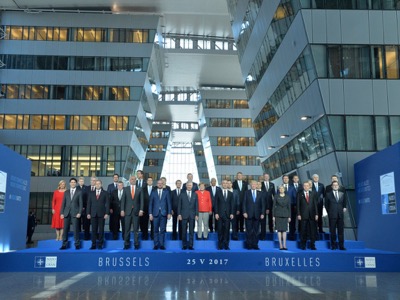Depending on your mental attitude, you will see the glass being half full or half empty. So Thierry Meyssan emphasizes what Donald Trump has achieved this week at the Nato and G7 summits, while Manlio Dinucci pauses to reflect upon Trump’s shortcomings – what he has failed to do. And so, a system is put in place – a system created not by laws debated and authorized by the Congress – but by the men encircling Trump. Men hell-bent on ensuring that Trump resists any change… enim sibi gerendum bellum est.

“An international order based on rules that promotes peace between nations, safeguards sovereignty, territorial integrity and political independence of all states and ensures the protection of human rights”: this is what the G7 leaders say they want. These leaders have gathered at Taormina, near the Sigonella base, the strategic centre in the Mediterranean for US /Nato wars and covert operations that have demolished the Libyan state and tried to do the same thing in Syria, accelerating the tragic flow of migrants out of the country – migrants whose human rights the G7 is said to be extremely concerned about.
The declarations track those of the Nato Summit at Brussels: the G7 is formed of the six biggest Nato members plus Japan which is the US’s and Nato’s principal ally in Asia. There is no shortage of economic and political divergences, dressed up as conflicting positions on climate change and migration. At the Summit, Trump irritated Merkel and the other leaders by recalling that “the US spends more on defence than all the other Nato countries put together”. Using a dictatorial tone, he has requested that all the allies uphold their commitment, assumed in 2014 with President Obama, to allocate at least 2% of their GDP to military expenditure. To date, the only countries to have crossed this threshold apart from the USA are Greece, Estonia, Great Britain and Poland. Sipri calculates that Italy’s military expenditure is 1.55% of the GDP which translates to around 70 million euro per day. If Italy were to increase expenditure to match Greece (2.36%, despite its economic crisis), it would spend more than 100 million per day; if it were to match US military expenditure (3.61%), it would spend more than 160 million euro per day. The 2%, insists Trump, is now insufficient given that the Alliance’s commitments have now increased. The Brussels Summit announced that Nato was entering into “the Global Coalition to crush Isis” (under the command of both the US and Nato) of which already 28 members of the Alliance are members.
Nato will provide Awacs radar airplanes and special forces for operations for the express purpose of combatting Isis (even though Isis plays a role in the US/Nato strategy to demolish states), aims at penetrating Syria to tear apart its territory and to circle Iran.
The Summit has also announced an increase in Nato troops in Afghanistan, today increased to 13,000 men.
In Europe, Nato continues its expansion to the East: Montenegro enters as the 29th member, already invited to the Summit. Montenegro, despite its small dimensions, is important for its geostrategic position and for its bunkers, in which Nato will deploy vast quantities of arms (which in all likelihood will include nuclear arms), and bomber fighters.
Nato – the Secretary-General Stoltenberg has declared at the Summit – “must react”” because it has before it a “Russia that is using military force to change the boundaries in Europe with its aggressive actions against Ukraine, illegally annexing Crimea and continuing to destabilize Eastern Ukraine”. Going even further than Trump, who has talked in general terms of “threats coming from Russia to the eastern boundaries of Nato”, the Summit has re-charged Russia of wanting to re-draw the boundary lines within the Europe with its aggressive use of military force. The Summit accuses Russia of reopening the raw wounds of the old Cold War, advancing the hypo of armed Russian tankers invading Europe.
Trump’s electoral pledge of wanting to start dialogue with Moscow is shattered to bits by a wall, invisible but powerful, built of those dominant US and European circles whose minds are fixed on a new Cold War and block every initiative with Moscow, threatening Trump himself with impeachment with the charge of conniving with the enemy.
While Trump beat Clinton, it is her ghost that now torments him, relentlessly like the Furies. For now, both at the G7 and Nato, the US President must take his seat at the table, as if he were a persona non grata.

 Articles by this author
Articles by this author Send a message
Send a message

















Stay In Touch
Follow us on social networks
Subscribe to weekly newsletter